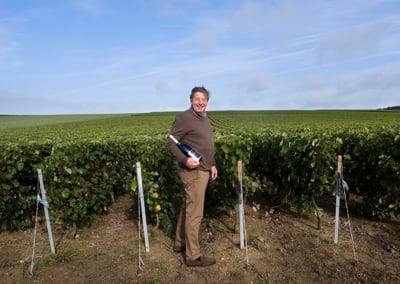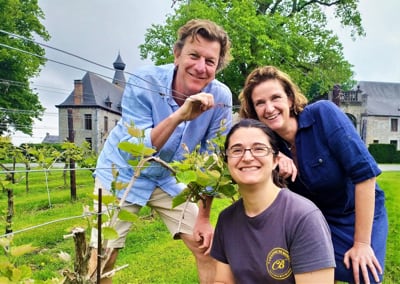When it comes to wine, discovering a new varietal, such as, say, a Sagrantino from Terre Margaritelli in Umbria, a Blaufrankish from Weingut Prieler in Burgenland, or a Sauvignon Gris blend from Chateau Petit Boyer in the Cotes de Bordeaux is among my favorite experiences. So you can imagine how excited I was when I met Laura Stigter, wine importer at Quirky Vine Selections, for lunch a few months ago, and she told me she was going to start importing Belgian wines to New York City.
I had had no idea they produced wine in Belgium. Beer? Of course. I mean who hasn’t heard of Belgian beer? But wine? That was news to me. Nevertheless, I decided, if Laura felt Belgian wines were worth importing, then I had little reason to doubt their quality. Laura’s been working in the wine industry for awhile now, and she has an equal knack for spotting hidden wine gems in world-renowned, as well as up and coming wine appellations.
Her eclectic portfolio consists of beautifully-crafted wines from predominantly family-owned and independent, organic and sustainable wineries. Laura’s also originally from Belgium and she believes Belgian wines offer not only quality, but a distinctive Northern European flavor unique to the region. I remember I was initially surprised to learn that winemaking existed in Belgium. Still, when you look at it from a geographical standpoint (it shares borders with the winemaking countries of France, Germany, Luxembourg, and the Netherlands), it makes sense that Belgium would have terroir suitable for wine production.
In fact, there are five appellations d’origine contrôlées (AOC) in Belgium. The AOCs of northern Belgium are located in Flanders. These include Hageland (the first to receive an AOC back in 1997), Haspengouw, Heuveland, and Maasvallei Limburg. The AOCs of southern Belgium are located in Walloon (Wallonia). These include the Côtes de Sambre et Meuse, as well as those for the sparkling wines Crémant de Wallonie, and Vin mousseux de qualité de Wallonie. White wines crafted from the AOC permitted varietals Chardonnay, Pinot Gris, Riesling, Auxerrois, Müller-Thurgau, Optima, Bacchus, Kerner, Ortega, Schönburger, Würzer, and Siegerrebe represent roughly 90% of Belgian wine production, but red grapes including Gamay, Pinot Noir, Domina, Blaufränkisch (Lemberger), and Dornfelder are also cultivated to produce rose’ and red wines.
Laura is currently the sole importer of Belgian wines in New York City, and she’s partnering with Steep Hill Wine for distribution. The first shipment contains sparkling Blanc de Blancs Brut from Ruffus Vignoble des Agaises, and white wine from Château de Bioul. It arrived in New York City one week ago and I can scarcely wait for my first taste of Belgian wine.

Ruffus Vignoble des Agaises is the largest winery in Belgium and the oldest in Walloon. It sits on a 57 acre-estate situated on a well-ventilated, south-facing hillside near Binche in Hainaut province. The winery takes its name from both Lord Ruffus, who presided over the area in the 12th century, and its location in the Les Agaises district. Ruffus Vignoble des Agaises is dedicated solely to the production of sparkling wines.

Ruffus Blanc de Blancs Brut is a Belgian sparkling wine produced using the méthode traditionnelle (the same process that is used in the production of champagne), and it’s made with 100% Chardonnay grapes grown on a chalk-rich soil that is identical to that found in Champagne. Chalk in the soil composition is ideal for cultivating the champagne grapes Chardonnay, Pinot Noir, and Pinot Meunier because it helps to maintain water level stability within the ground. Moreover, chalk also provides the soil with good drainage, and prevents it from becoming overly saturated. Chalk is prevalent throughout the area in and around the Vignoble des Agaises (there’s even a chalk mine in the vicinity). Incidentally, it’s the presence of chalk that gives The White Cliffs of Dover (a 3 and 1/2 hour drive from the winery) its pearly facade. The Vignoble des Agaises is less than three hours by car from the city of Reims, where some of the most famous champagne houses are located.

Château de Bioul is a certified organic winery that engages in biodynamic principles of winemaking. It’s situated on an 11th century estate within the Côtes de Sambre et Meuse in Walloon. The Côtes de Sambre et Meuse was the first winemaking area to receive an AOC (established in 2004) in Walloon. It’s located between the Sambre and Meuse Rivers roughly 60 miles from the city of Liège. Winemaking in this appellation dates back to the 9th century.

Château de Bioul “Terre Charlot” is a refreshing organic white wine produced from Solaris grapes cultivated on schist soil. Solaris is a hardy white grape that thrives particularly well in the cool climate of southern Belgium. Solaris is of the vitis vinifera variety, although the infusion of just enough American vines into the genetic equation has made this grape resistant to most diseases and therefore, a prime candidate for organic and biodynamic viticulture.
I’ll provide an update on these wines after I try them!
- Laura Stigter
- Quirky Vine Selections
- 1 (347) 223-3978
- quirkyvine@gmail.com/laurascarino@gmail.com
- Steep Hill Imports LLC
- 17 Cook Avenue
- 07490 Madison – NJ USA
- 1 (347) 683 6394
- info@steephillwine.us
- Ruffus Vignoble des Agaises
- Chemin d’Harmignies 1, 7120 Estinnes, Belgium
- info@ruffus.be
- Château de Bioul
- Place Vaxelaire 1, 5537 Bioul, Belgium 003271799943
- info@chateaudebioul.com

Be First to Comment